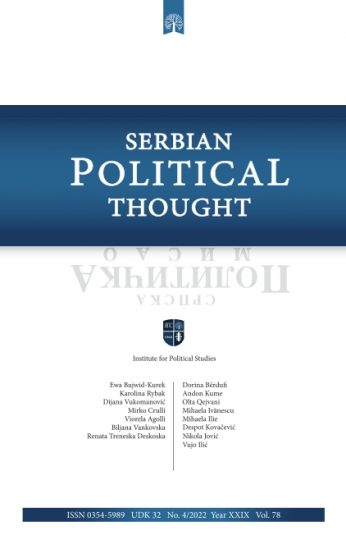Main topic
Serbian Political Thought
The Scope and Objective of Treaty-Based Flexibility Arrangements in The Area of European Security and Defence Policy (ESDP)
Abstract
From the very beginning of its existence, the European Community has been facing the problem of harmonizing the process of integration and heterogeneity. The challenge has been to organize a growing diversity within the Union without jeopardizing the dynamics of integration. In the area of foreign, security and defence policy, this heterogeneity is particularly marked, whereas unanimity is the principal way of decision-making. It was therefore necessary to provide for such forms of flexibility which would not block the development of this policy. The development of the EU security and defence policy is a result of differentiation which has been the core of the framing of this policy from the very beginning. Therefore, within this policy, differentiation occupies a position which it does not have in any other Union policies. The purpose of this paper is to analyse Treaty provisions on flexible cooperation within the EU foreign, security and defense policy. Their aim is to enable states to implement cooperation within the institutional framework of the EU, and conversely, to enable those states which refuse participation not to become involved. These innovations imply certain risks, since flexibility creates additional institutional complexity and may create a rift between states which choose to advance and those not willing to do so.
References
- Balmond, L. (2004) ‘L’Union européenne, une organisation de défense?’ in: Archour В., Laghmani S. (eds.) Le droit international à la croisée des chemins. Force du droit et droit de la force. Paris: Pedone, pp. 291-314.
- Biscop, S. (2008) ‘Permanent Structured Cooperation and the Future of ESDP: Transformation and Integration’. Paper presented at the 3rd Seminar in the EUISS-coodinated series on the European Security Strategy: “Strengthening ESDP: The EU’s Approach to International Security”, Helsinki, 18-19 September 2008.
- Blanck, K. (2004) ‘Flexible integration in the Common Foreign and Security Policy1. Europainstitut Working Paper, n° 61.
- Blanquet, M. (2001) ‘Commentaire de l’article 27A! in: Rideau J. (ed.) Union européenne- Commentaire des traités modifiés par le traité de Nice du 26février 2001. Paris: LGDJ, pp. 63-67.
- Bono, G. (2004) ‘La PESC et la PESCD dans la Constitution européenne. Evaluation sur la base du projet de la Convention’. Annuaire français de relations internationales, 5: 556-563.
- Burgorgue-Larsen, L. (2003), ‘Le droit communautaire dans tous ses états ou les désordres du in et du out’, in: Mélanges en hommage à Guy Isaac. 50 ans du droit communautaire. Toulouse: Presses de l’Université des Sciences sociales, pp. 121-136.
- Chaltiel, F. (1998), ‘Le traité d’Amsterdam et la coopération renforcée’. Revue du Marché commun et de ÎUnion européenne, 418: 288-293.
- Chopin, T., Jamet, J-F. (2008) Ta différenciation peut-elle contribuer à l’approfondissement de l’intégration communautaire?’, Questions d’Europe, 106-107, [online]. Available at: http:// robert-scuman.eu/doc/questions_europe/qe-106_etl07-fr.pdf [Accessed 21 July 2010].
- Cremona, M. (2009), ‘Enhanced Cooperation and the Common Foreign and Security and Defence Policies of the EU’. EUI Working Paper LAW, 2009/21.
- Cremona, M. (2003), ‘The Draft Constitutional Treaty : External Relations and External Action’. Common Market Law Review, 40(6): 1347-1366.
- De la Serre, F. (2002) ‘La coopération renforcée’, in : Magnette, P. (ed) La Constitution de l’Europe. Bruxelles: Editions de l’Université libre de Bruxelles, pp. 167-178.
- De la Serre, F. (2001) ‘La PESC et coopération renforcée’. International Law FORUM du droit international, 3(4): 243-246.
- De La Serre, E, Wallace, H. (1997) Les coopérations renforcées: une fausse bonne idée ?. Paris: Fondation Notre Europe.
- Delcourt, B. (2004) ‘Entre réalisme et modestie : les nouveaux atours de la PESC’ in: Magnette, P. (ed.), La Grande Europe. Bruxelles: Université Libre de Bruxelles, pp. 303-319.
- Diedrichs, U. (2004) ‘Flexibility and ESDP : From the Convention to the IGC and Beyond’. CF SP Forum, 2 (2): 1-6.
- Diedrichs, U., Jopp, M. (2003) ‘Flexible Modes of Governance: Making CFSP and ESDP World International Spectator, 38(3): 15-30.
- Dumoulin, A. (2000) ‘La gestion de aises infra-institutionnelles. La montée en puissance des directoires et des coopérations croisées’. La revue internationale et stratégique, 7: 21-30.
- Fines, F. (2000) Ta réforme des coopérations renforcées’. Revue des affaires européennes, 4: 359-373.
- Howorth, J. (2004) ‘The European Draft Constitutional Trentin and the Future of the European Defence Initiative: A Question of Flexibility! European Foreign Affairs Review, 9(4): 483-508.
- Jaeger, T. (2002) ‘Enhanced Cooperation in the Treaty of Nice and Flexibility in the Common Foreign and Security Policy’. European Foreign Affairs Review, 7(3): 297-316.
- Latour, X. (2000) ‘La coopération renforcée et la Politique européenne de sécurité et de défense’, in : Hervouët, F. (ed.), Démarche communautaire et construction européenne. Dynamique des méthodes (vol. 2). Paris: La Documentation française, pp. 365-380.
- Manin, P. ‘La ‘coopération renforcée”, in Le traité d’Amsterdam: réalités et perspectives. Actes du colloque (Universités Paris I, Paris II et Bordeaux IV), Paris, 27-28 février 1998. Paris: Pedone, pp. 135-155.
- Manin, P. (1996) ‘Les aspects juridiques de l’intégration différenciée’, in: Manin, R, Louis, J-V (eds.), Vers une Europe différenciée? Possibilité et limites. Paris: Pedone, pp. 9-32.
- Philippart, E., Edwards G. (1999) ‘The Provisions on Closer Co-operation in the Treaty of Amsterdam: The Politics of Flexibility in the European Union’. Journal of Common Market Studies, 37(1): 87-108.
- Santopinto, F. (2009) ‘Le traité de Lisbonne et la défense européenne: Bataille diplomatique sur fond de Coopération structurée permanente’, Note d’Analyse du GRIP, [online]. Available at: http://www.grip.org/fr/siteweb/images/NOTES_ANALYSE/2009/NA_2009-ll-04_FR_F-SANTOPINTO.pdf. [Accessed 24 July 2010].
- Stubb, A. (2002) Negotiating Flexibility in the European Union: Amsterdam, Nice and beyond. New York: Palgrave Macmillan.
- Stubb, A. (1996) ‘A Categorization of Differentiated Integration’. Journal of Common Market Studies, 34(2): 283-295.
- Тоrо, C. (2005) ‘The Latest Example of Enhanced Cooperation in the Constitutional Treaty: The Benefits of Flexibility and Differentiation in European Security and Defence Policy Decisions and their Implementatio’. European Law Journal, 11(5): 641-656.
- Vukčević, D. (2008) Bezbednost i Evropska unija. Bezbednosna politika Evropske unije – institucionalne osnove. Beograd: Institut za političke studije.

